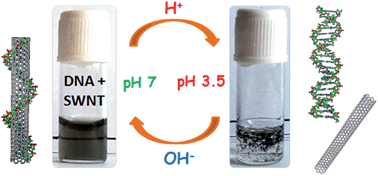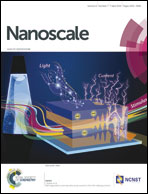Role of pH controlled DNA secondary structures in the reversible dispersion/precipitation and separation of metallic and semiconducting single-walled carbon nanotubes†
Abstract
Single-stranded DNA (ss-DNA) oligomers (dA20, d[(C3TA2)3C3] or dT20) are able to disperse single-walled carbon nanotubes (SWNTs) in water at pH 7 through non-covalent wrapping on the nanotube surface. At lower pH, an alteration of the DNA secondary structure leads to precipitation of the SWNTs from the dispersion. The structural change of dA20 takes place from the single-stranded to the A-motif form at pH 3.5 while in case of d[(C3TA2)3C3] the change occurs from the single-stranded to the i-motif form at pH 5. Due to this structural change, the DNA is no longer able to bind the nanotube and hence the SWNT precipitates from its well-dispersed state. However, this could be reversed on restoring the pH to 7, where the DNA again relaxes in the single-stranded form. In this way the dispersion and precipitation process could be repeated over and over again. Variable temperature UV-Vis-NIR and CD spectroscopy studies showed that the DNA-SWNT complexes were thermally stable even at ∼90 °C at pH 7. Broadband NIR laser (1064 nm) irradiation also demonstrated the stability of the DNA-SWNT complex against local heating introduced through excitation of the carbon nanotubes. Electrophoretic mobility shift assay confirmed the formation of a stable DNA-SWNT complex at pH 7 and also the generation of DNA secondary structures (A/i-motif) upon acidification. The interactions of ss-DNA with SWNTs cause debundling of the nanotubes from its assembly. Selective affinity of the semiconducting SWNTs towards DNA than the metallic ones enables separation of the two as evident from spectroscopic as well as electrical conductivity studies.


 Please wait while we load your content...
Please wait while we load your content...